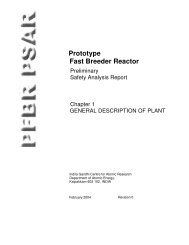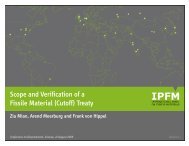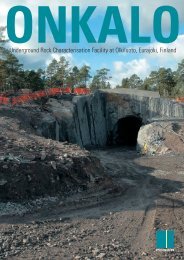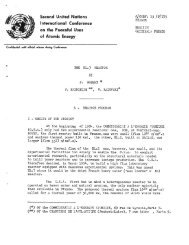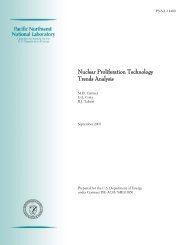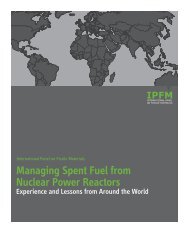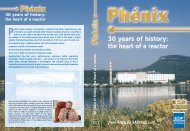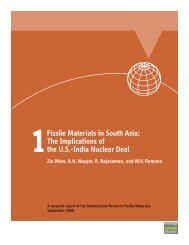Global Fissile Material Report 2009: A Path to Nuclear Disarmament
Global Fissile Material Report 2009: A Path to Nuclear Disarmament
Global Fissile Material Report 2009: A Path to Nuclear Disarmament
You also want an ePaper? Increase the reach of your titles
YUMPU automatically turns print PDFs into web optimized ePapers that Google loves.
Figure 1.2. National s<strong>to</strong>cks of highly enricheduranium as of mid-<strong>2009</strong>. The numbers for the UnitedKingdom and United States are based on theirpublications. The civilian HEU s<strong>to</strong>cks of France, theUnited Kingdom are based on their public declarations<strong>to</strong> the IAEA. Numbers with asterisks arenon-governmental estimates, often with largeuncertainties. 22 Numbers for Russian and U.S.excess HEU are for June <strong>2009</strong>. HEU in non-nuclearweapon (NNW) states is under IAEA safeguards. A20% uncertainty is assumed in the figures for <strong>to</strong>tals<strong>to</strong>cks in China, Pakistan and Russia, and for themilitary s<strong>to</strong>ckpile in France, and 50% for India.United States. As of mid-<strong>2009</strong>, the United States had down-blended cumulatively about124 <strong>to</strong>ns of highly enriched uranium 23 —mostly less than weapon-grade. Based on thedeclared <strong>to</strong>tal inven<strong>to</strong>ry of 741 <strong>to</strong>ns from September 1996, this leaves 109 <strong>to</strong>ns of excessHEU (mostly for blend-down), about 30 <strong>to</strong>ns of civilian HEU (fresh and irradiated),about 100 <strong>to</strong>ns of HEU in spent naval reac<strong>to</strong>r fuel, which is <strong>to</strong> be disposed of as radioactivewaste, and about 380 <strong>to</strong>ns of unirradiated HEU in the military s<strong>to</strong>ckpile. Thismilitary <strong>to</strong>tal includes about 250 <strong>to</strong>ns available for weapons and 128 <strong>to</strong>ns of fresh HEUreserved for naval propulsion. 24Pakistan. Pakistan may be the only country producing HEU for weapons <strong>to</strong>day. It isbelieved <strong>to</strong> have first achieved the capacity <strong>to</strong> produce a significant quantity of HEU inthe early 1980s and <strong>to</strong> have built up its enrichment capacity using P-2 centrifuges andlater more advanced P-3 and P-4 designs. 25 There have been claims that, along withits Kahuta enrichment facility, Pakistan may have an enrichment plant at Gadwal. 26<strong>Report</strong>edly near Wah, about 30 kilometers from Islamabad, Gadwal was described recentlyas a facility where already enriched uranium (presumably from Kahuta) is enrichedfurther <strong>to</strong> weapon-grade. 27Pakistan’s annual HEU production capacity is constrained by its limited domesticproduction of natural uranium and the need also <strong>to</strong> fuel its Khushab-I plu<strong>to</strong>niumproduction reac<strong>to</strong>r. To address this problem, Pakistan may have started <strong>to</strong> use reprocesseduranium recovered from Khushab spent fuel as feed for its uranium-enrichmentprogram. We estimate Pakistan’s enrichment capacity <strong>to</strong> be on the order of 30,000<strong>Global</strong> <strong>Fissile</strong> <strong>Material</strong> <strong>Report</strong> <strong>2009</strong> 13



